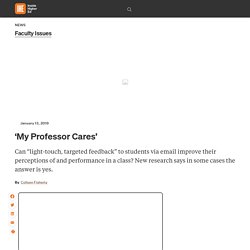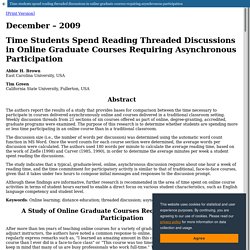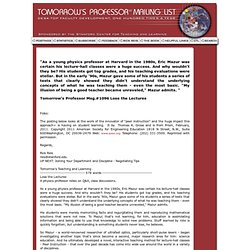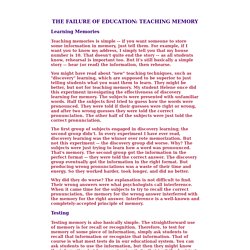Teach for Learning
Jaime Escalante Math Program - The Futures Channel. Intro by Jaime Escalante In recent years I have been deluged with questions from interested teachers, community leaders, and parents about my success in teaching mathematics to poor minority children.

I am not a theoretician, my expertise is in the classroom and my first commitment is to my students. Nonetheless, I am willing to share my opinions on this subject in the hope that they might be helpful to other professionals in the field of education. I am hopeful this article will provide answers.
I'm not crying.. : MadeMeSmile. Why was I taught cursive in school in the late 90s when I've never actually used it in my life outside of elementary school and writing my own signature? In fact, I don't know anyone who writes in cursive. : NoStupidQuestions. 5 Teaching Practices I'm Kicking to the Curb. Can 'light-touch, targeted feedback' to students improve their perceptions of and performance in a class?
Students benefit from increased faculty engagement.

Yet many professors still resist more student-centered teaching. Part of the problem is that graduate schools are slow to adopt pedagogical training, meaning that some professors may want to up their interaction with students but don’t know how. Another part of the problem is that becoming a better teacher takes time, an increasingly scarce faculty resource. What if engagement wasn’t complicated and didn’t take that much time? Preliminary research called "My Professor Cares: Experimental Evidence on the Role of Faculty Engagement," presented last week at the annual meeting of the American Economics Association, suggests that even “light touch” interventions can make a difference to students. “Everything we know from K-12 education is that teaching matters,” said co-author Michal Kurlaender, professor and chancellor’s fellow in education at the University of California, Davis.
Another Setting. 'Academically Adrift'
If the purpose of a college education is for students to learn, academe is failing, according to Academically Adrift: Limited Learning on College Campuses, a book being released today by University of Chicago Press.

The book cites data from student surveys and transcript analysis to show that many college students have minimal classwork expectations -- and then it tracks the academic gains (or stagnation) of 2,300 students of traditional college age enrolled at a range of four-year colleges and universities. The students took the Collegiate Learning Assessment (which is designed to measure gains in critical thinking, analytic reasoning and other "higher level" skills taught at college) at various points before and during their college educations, and the results are not encouraging: "How much are students actually learning in contemporary higher education?
Test Design
Time students spend reading threaded discussions in online graduate courses requiring asynchronous participation. Abbie H.

Brown East Carolina University, USA Tim Green California State University, Fullerton, USA Abstract The authors report the results of a study that provides bases for comparison between the time necessary to participate in courses delivered asynchronously online and courses delivered in a traditional classroom setting. Weekly discussion threads from 21 sections of six courses offered as part of online, degree-granting, accredited, graduate programs were examined. The discussion size (i.e., the number of words per discussion) was determined using the automatic word count function in MS Word. The study indicates that a typical, graduate-level, online, asynchronous discussion requires about one hour a week of reading time, and the time commitment for participatory activity is similar to that of traditional, face-to-face courses, given that it takes under two hours to compose initial messages and responses to the discussion prompt. The authors address the following questions: Method.
Reading
Eric Mazur: Memorization or understanding: are we teaching the right thing?
1096 Lose the Lectures. Folks: The posting below looks at the work of the innovator of "peer instruction" and the huge impact this approach= is having on student learning.

It by Thomas K. Grose and is from Prism, February, 2011. Copyright 2011 American Society for Engineering Education 1818 N Street, N.W., Suite 600 Washington, DC 20036-2479 Web: www.asee.org Telephone: (202) 331-3500. Reprinted with permission.
Formula for success in learning. If you have found this place in the vast cyberspace of the web, you are probably not the one to convince that knowledge is power, and that solutions to most problems facing humanity could be found if we were armed with more understanding of how the world works.

While knowledge is power, information can be overpowering. An increasing proportion of the population suffers from Information Fatigue Syndrome, i.e. from stress related to being overwhelmed with an unmanageable glut of information. This text introduces you to simple steps toward managing information and toward rock-solid knowledge.
TEACHING MEMORY. Learning Memories Teaching memories is simple -- if you want someone to store some information in memory, just tell them.

For example, if I want you to know my address, I simply tell you that my house number is 10. That doesn't quite end the story -- as all students know, rehearsal is important too. But it's still basically a simple story -- hear (or read) the information, then rehearse.
Memory Techniques. Peer Instruction in the Humanities Project. How One Instructor Got Students to Pay Attention to Class Rules.







